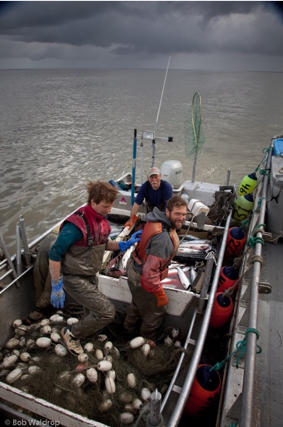What’s at stake?
On average, 40-50 million wild salmon make the epic migration from the ocean to the headwaters of Bristol Bay every year—like no place else on earth!

The Bristol Bay watershed:
- supplies roughly 50% of the world’s commercial supply of wild sockeye salmon.
- generates more than $1.5 billion a year in economic value, and
- employs 14,000 workers.
This world-class resource is at risk from the proposed Pebble Mine, a massive copper and gold mine that would destroy salmon habitat, and cause lasting harm to this phenomenally productive ecosystem. According to the Draft Environmental Impact Statement, Phase 1 of the proposed Pebble Mine would:
- Destroy more than 80 miles of streams and 3,500 acres of wetlands
- Create a toxic pit lake filled with 61 billion gallons of mine water
- Generate billions of gallons of mine pollution each and every year that will require treatment in perpetuity
- Build and operate a 230 MW power plant
- Lay a 188-mile long natural gas pipeline over land and under Cook Inlet and Iliamna Lake – Alaska’s largest freshwater lake
- Create a barge system across Lake Iliamna to transport mine concentrate
The Bristol Bay salmon fishery is a sustainable and renewable resource, whereas the ore from the Pebble mine is nonrenewable. The ore will be shipped overseas to Asia, the profits will go to a foreign mining company, while the severe and lasting impacts stay here. In contrast, if the clean water and wild salmon habitat of the Bristol Bay watershed are protected, the salmon fishery can continue to feed our nation and power our economy forever. Perpetual pollution or perpetual salmon? An easy choice.
Protecting America’s Greatest Salmon Fishery
Alaska native communities and commercial fishermen, who rely on the sustainable salmon fishery for their way of life and livelihoods, strongly oppose the proposed mine.
“The pure waters of Bristol Bay have sustained my family for generations,” says Everett Thompson, a commercial fisherman and shareholder in the Bristol Bay Native Corporation. “This watershed provides a subsistence lifestyle and commercial fishery worth fighting for.”
Earthworks worked with leading jewelry retailers, including Tiffany & Co., Zales, Ben Bridge, Helzberg Diamonds, and others, to express their support for protecting Bristol Bay from the Pebble mine—recognizing that the Bristol Bay watershed is an ecosystem of international significance.
Restaurants, chefs, supermarkets, churches, scientists, hunters and anglers have all urged protection for the Bristol Bay salmon fishery from the proposed Pebble Mine.
The Clean Water Act

Alaska Native communities, commercial and sports fishermen, businesses, conservation groups, and sportsmen called on the EPA to protect Bristol Bay from the impacts of large-scale mining. They petitioned the EPA to use its authority under Section 404(c) of the Clean Water Act to protect the salmon’s spawning grounds from mine waste disposal.
The EPA’s scientific assessment determined the construction of a large-scale mine in the area would result in lasting harm to the salmon fishery. In July 2014, the EPA initiated a proposal, called the Proposed Determination, placing reasonable limitations on mine waste disposal in the Bristol Bay headwaters to protect the salmon fishery.
Despite over 1.6 million comments of support for these Clean Water Act protections, including over 20,000 Alaskans, the EPA under the Trump Administration, initiated a process to reverse course on its proposed protections, and withdrew these important salmon protections in July 2019.
Educating Investors and the Industry

Over the last decade, Earthworks and our allies have provided information about the extensive opposition and significant risks of the Pebble Mine, and met directly with the CEOs of major mining companies to educate them about the importance of Alaska’s Bristol Bay. Anglo American canceled its investment in 2013. Rio Tinto followed suit in 2014. And, First Quantum Minerals withdrew in 2018. Now, Northern Dynasty, a small Canadian company, is the only company left, with no major mining company to providing financial support for project development.
The Permitting Process
On January 5, 2018, Pebble submitted its permit application to the Army Corps of Engineers. The submission of this permit also triggered the environmental review process, and the Army Corps released the Draft Environmental Impact Statement in February 2019. Earthworks and our conservation partners conducted an extensive review of the draft EIS, documenting serious and widespread flaws. Despite these severe problems, the Draft EIS demonstrates that phase 1 of the Pebble Mine would have devastating consequences for salmon, including the loss of 80 miles of streams and 3,500 acres of wetlands.
Despite a decade’s worth of widespread opposition to the Pebble Mine, the threat to Bristol Bay continues. Please join us in our efforts to protect the world’s greatest wild salmon fishery!
For More Information
- Blog: Why Anglo walked away from the planet’s richest undeveloped gold deposit
- Earthworks report: US Copper Porphyry Mines
- Press release: 100 Jewelers Pledge Support for Bristol Bay from Pebble Mine
- Press release: Food Retail Industry Flexes Its Muscle for Alaska’s Bristol Bay
- Press release: Alaska Native Leaders & Fishermen Tell First Quantum: Dump Pebble Mine
Your Support Makes Our Work Possible
Earthworks helps families on the front lines of mining, drilling, and fracking. We use sound science to expose health, environmental, economic, social, and cultural impacts of mining and energy extraction. To support our efforts, please consider a tax-deductible donation today that will go toward our work reforming government policies, improving corporate practices, influencing investment decisions, and encouraging responsible materials sourcing and consumption.


